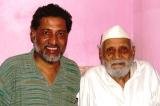Independence Day functions in School were a reminder for students on India’s Freedom struggle. Today for many it’s a holiday and for some watching PM speak from the rampart of Red Fort. Our freedom struggle is a period in Indian history and its culmination in the making of our constitution and today making us the biggest democracy.
The history and formation of the Indian National Army (INA) or the Azad Hind Fauj, started in Far East and South East Asia. The bulk of the soldiers were the Prisoners of war (POWs) captured by the advancing Japanese forces mainly in Malaysia and Singapore. Many were initially reluctant to join the INA, but later joined after coming of Subhas Chandra Bose-Netaji in the picture. I met 92 years old Captain Raghuvansh Lal Awasthi of the Indian National Army (INA) at Dehradun.
Capt Awasthi is not from the armed forces background. Capt Awasthi was born in village Bighapur in Unnao district of Uttar Pradesh. He did his B.Sc from DAV college Kanpur. He was with the department of telecommunication in the British Period and initially posted in Kolkatta as a wireless operator. He was next posted to Port Blair in Andamans by the British government despite his reluctance. In world War second the Japanese attacked the Andamans and Nicobar Islands, and occupied the islands and the administrative headquarters of Port Blair.
The only Indian territory under Japanese occupation was the Islands of Andaman and Nicobar. The administration and atrocities committed by the Japanese is a different story to tell. Captain Awasthi was arrested in Port Blair and sent to Penang Island in Malaysia by the Japanese.
At Penang he was introduced to Baba Hari Singh Usman of the Gaddar Party. He assisted Baba Hari Singh Usman as his personal assistant, as he was educated and could take care of his official correspondence and other communication. The life and political adventures of Baba Hari Singh Usman is an interesting story of man devoted to see the freedom of his country. In this period Capt. Awasthi travelled to various places in Malaysia, like Kuala Lumpur and Singapore.
The Japanese sent him to Rangoon, to mobilise Indians against the British Rule. Some of the Indian he meet lived in a area called Jeeavadi in Rangoon and they were in Suger Plantations and worked in a Sugar Mill in the area. He was later called to join the Indian National Army at Rangoon and combat trained for six months and then commissioned as an officer in INA due to his qualification.
He could remembers the name of Sita Ram Goswami who belonged to Gonda/Bhairaich and Kishan Rajpalta from Punjab who were his colleagues in the Army training camp in Rangoon. When Subhas Chandra Bose Netaji interviewed him in Rangoon, he was called to take up the secret service work of the INA, may be due to his background in telecommunication.
It was in Rangoon that the INA regrouped to strategize their military options. After the defeat of the Japanese all over and so also in Burma, the British Indian Army entered Burma and most of the Japanese along with the INA soldiers were arrested. Captain Awasthi was arrested from a tea shop in Rangoon and sent to Red Fort in Delhi as a prisoner. After his release he went to his village and was given a hero’s welcome in his area.
Few months later was approached by some Britishers to join an educational institution in Uganda, which he did and lived there for many years before shifting to Zambia, again in an educational institute for few more years. He came back to India sometimes in the year 1983 and later settled in Dehradun. I was sad to hear at the end of my interview, when he said, ‘I dont want to live anymore’
